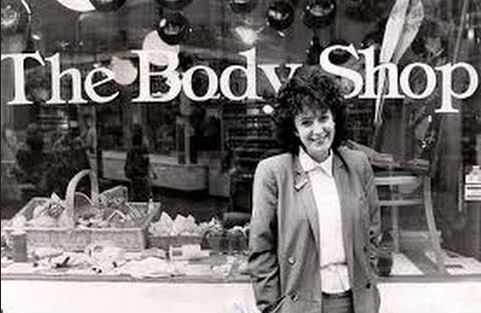
Dame Anita Roddick, founder of The Body Shop, managed to become famous as a national treasure before her tragic death at the age of 64.
Anita, an entrepreneur and human rights activist, changed the face of cosmetics retail forever, and for many years, many could not imagine a shopping trip without visiting her instantly recognizable skincare and cosmetics chain.
The first ethical cosmetics
But now, the iconic green store faces uncertain times, as its owners appoint finance directors after a dreary festive season. As part of the company's new restructuring plan, bosses will close half of its UK stores, leaving workers' futures in limbo.
For many loyal customers, the drop represents the end of an era, a nostalgic reminder of the days when The Body Shop felt like the beginning of a consumer revolution and a new, kinder way to shop. For Anita, the company was her life's work – but with great success came many difficult times.
An avid traveler, Anita drew inspiration from her time spent in Europe, Africa and the Far East, where she observed the natural cosmetics used by the women she met.
Early life and starting a business
Anita was born in Littlehampton, West Sussex in 1942, and was raised by Italian parents who ran a café. Before venturing into the world of ethical cosmetics, Anita worked as an English teacher and at one point ran a bed and breakfast.
An avid traveler, Anita drew inspiration from her time spent in Europe, Africa and the Far East, where she observed the natural cosmetics used by the women she met.
After returning to England, Anita met and fell in love with fellow bohemian Gordon Roddick, and they married in 1970. Anita opened the first branch of The Body Shop in 1976 to support herself and her two daughters, Sam and Justine, while her husband Gordon was away pursuing a personal goal – riding From Buenos Aires, Argentina to New York on horseback.
“The original Body Shop was a series of wonderful accidents. It smelled wonderful, it had a fancy name. It was sandwiched between two funeral homes – and that was always controversial. It was incredibly sensual.”
Between two funeral homes
The modest store in Brighton used handwritten labels and kept costs down with minimal packaging. Customers were impressed by the environmental focus and high-quality products at affordable prices, and Anita was able to open a second store after just six months.
“The original Body Shop was a series of wonderful accidents,” Anita said, reflecting on those humble early days years later in 1991, when it was considered a national treasure. “It smelled wonderful, and it had a fancy name. It was sandwiched between two funeral homes — “That was always controversial. It was incredibly sensual.”
“We recycled everything, not because we were environmentally friendly, but because we didn't have enough bottles.”
We were recycling because we ran out of other bottles
“It was 1976, the year of the heat wave, so there was a lot of meat around. We knew the storytelling style of the time, so all the products had stories. We recycled everything, not because we were environmentally friendly, but because we didn’t We don't have enough bottles.
“It was a good idea. What was unique about it, without any intention, without any marketing savvy, was that it translated across cultures, across geographic barriers and social structures. It wasn't an elaborate plan, it just happened that way,” Anita continued her story.
Clear success
The initially small brand, which started with just £4,000, began expanding at breakneck speed, and by 1982, an average of two stores were set up a month – proving that entrepreneurs can be passionate and hugely successful.
By 1984, The Body Shop had established a strong presence on the high street and listed its shares on the London Stock Exchange. The value of the separate land business was previously estimated at £80 million.
By the turn of the millennium, The Body Shop had 2,000 stores in 55 countries – making a name for itself on the global stage. There was some backlash following Anita's decision to sell her company to L'Oréal in March 2006, with many seeing it as not being in keeping with the store's early radical ethos.
Change the rules
However, Anita defended her controversial decision, explaining: “Campaigning, being outspoken, changing the rules of work – it's all there, it's protected.
“And it won't change. That's part of our DNA. But for L'Oréal to come in and say we love you, we love your morals, we want to be a part of you, we want you to teach us things, it's a gift. I'm excited about that. So I don't see it as a sellout.”
Watch the related video
Diagnosis of trauma and chronic diseases
In February 2007, Anita announced that she had contracted hepatitis C as a result of a blood transfusion in hospital after the birth of her daughter, Sam, in 1971. She had lived with the disease for 30 years without realizing it, and only learned of her condition after medical tests. Routine in her blood.
By then, Anita was suffering from cirrhosis – one of the most serious long-term effects of the disease, leading to scarring and poor liver function. “I suffer from cirrhosis of the liver,” Anita said in a post on her website. I could still live a good few years — maybe even decades — but it's hard to say. “I might face liver cancer tomorrow.”
Death at the age of only 64 years
He added: “Having hepatitis C means that I live with a strong sense of my own mortality, which in many ways makes life more vivid and immediate. This makes me more determined to keep things going.”
Turning her plight into activism, Anita became a patron of the Hepatitis C Fund and called on the government to take the disease more seriously as a “public health challenge.”
On September 10, 2007, Anita died at the age of 64 after suffering a cerebral hemorrhage – a rare complication of hepatitis C. A statement from her family read: “Gordon, Justine and Sam Roddick are deeply saddened to announce that following a serious brain haemorrhage, Anita Roddick passed away at 6.30pm today at the age of 64.
Anita Roddick was admitted to St Richard's Hospital in Chichester, near her home, last night when she collapsed after complaining of a sudden headache. Mrs Roddick was admitted to the hospital's intensive care unit and her husband Gordon and daughters Sam and Justine were with her when she died.
Ahead of its time
Following the sad news, tributes have poured in for Anita, with many remembering her as a powerful force for change in the retail sector, prioritizing green issues on the high street long before such issues became widespread.
In a statement at the time, John Sovin, executive director of Greenpeace, said: “She was an amazing inspiration to those around her, not just on environmental and human rights issues, which were her passion.
“She was ahead of her time when it came to issues of how to do business in different ways, not just with a profit motive, but with environmental issues in mind. Today every company claims to be environmentally friendly, and they were living this for decades ago. She was a true pioneer.” .
*With data from Mirror.co.uk

“Avid problem solver. Extreme social media junkie. Beer buff. Coffee guru. Internet geek. Travel ninja.”





More Stories
If it weren’t for the merger of Attica Bank and Bankritia, they could have collapsed.
Debt: When will it return to 60% of GDP – “Snowball” Stournara and the Greek Bell
Revolut, Paypal, AADE Sweepstakes – Grace Period Has Ended